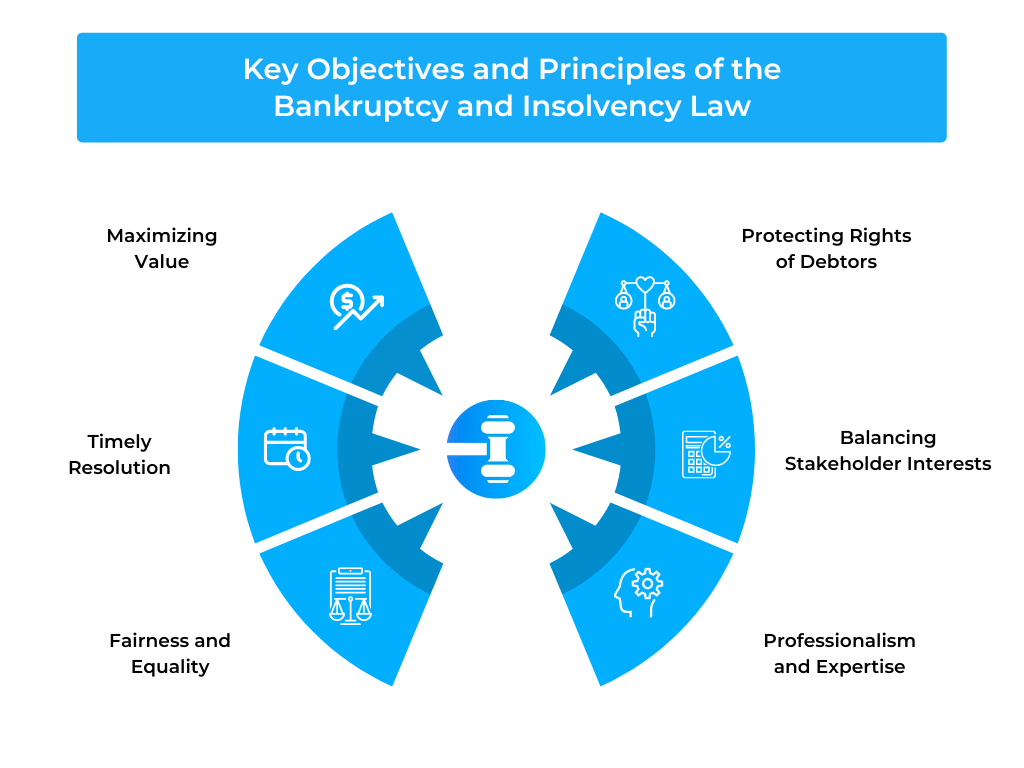Bankruptcy and Insolvency law in India
Introduction to Bankruptcy

The bankruptcy and insolvency law in India has undergone significant reforms with the introduction of the Insolvency and Bankruptcy Code (IBC) in 2016. This legal framework aims to address financial distress, promote creditor interests, and facilitate the timely resolution of insolvency cases. The IBC has improved the ease of doing business, protected stakeholders, and fostered a transparent insolvency ecosystem. This article provides an overview of the key provisions of the bankruptcy and insolvency law in India, including processes, mechanisms, recent developments, challenges, and the impact on stakeholders and the economy.
Understanding the Insolvency and Bankruptcy Code (IBC) in India
The Insolvency and Bankruptcy Code (IBC) is a significant legislation introduced in India in 2016 to address insolvency and bankruptcy issues. It provides a time-bound framework for the resolution of stressed assets, protecting stakeholders’ interests and promoting ease of doing business. The IBC covers corporate entities, partnership firms, and individuals, aiming to maximize asset value, ensure a fair resolution process, and boost investor confidence. The National Company Law Tribunal (NCLT) oversees the insolvency resolution process, and the Insolvency and Bankruptcy Board of India (IBBI) regulates the involved entities. The IBC’s key feature is the Insolvency Resolution Process (IRP), facilitated by a resolution professional who formulates a viable resolution plan for creditors’ approval. The IBC has improved recovery rates, reduced resolution time, and fostered a culture of accountability and discipline. It has also encouraged business restructuring and economic growth.
Key Objectives and Principles of the Bankruptcy and Insolvency Law

The bankruptcy and insolvency law in India is designed to achieve several key objectives and uphold essential principles. These objectives and principles play a crucial role in the effective functioning of the insolvency framework and the resolution of distressed entities. Some of the key objectives and principles include:
- Maximizing Value: The primary objective is to maximize the value of the debtor’s assets and ensure the best possible outcome for all stakeholders involved. This involves efficient and transparent asset valuation, effective restructuring or liquidation processes, and fair distribution of proceeds among creditors.
- Timely Resolution: Another objective is to facilitate the timely resolution of insolvency cases. The law emphasizes strict timelines to prevent delays in the resolution process, promoting efficiency and reducing the economic costs associated with prolonged insolvency proceedings.
- Fairness and Equality: The bankruptcy and insolvency law promotes fairness and equality among creditors. It aims to ensure that all creditors are treated equally and have an opportunity to participate in the resolution process. This helps protect the rights and interests of creditors and promotes a level playing field for all stakeholders.
- Protecting Rights of Debtors: The law also recognizes the importance of protecting the rights of debtors. It provides an opportunity for debtors to seek relief from financial distress, explore restructuring options, and have a chance to revive their businesses. This helps balance the interests of creditors with the need to support viable businesses and promote entrepreneurship.
- Balancing Stakeholder Interests: The law seeks to strike a balance between the interests of various stakeholders, including creditors, debtors, employees, and shareholders. It aims to facilitate a resolution that is fair and equitable, taking into account the interests of all parties involved.
- Professionalism and Expertise: The bankruptcy and insolvency law emphasizes the importance of professionalism and expertise in the resolution process. It mandates the involvement of qualified insolvency professionals who possess the necessary skills and knowledge to handle complex insolvency cases. This ensures the effective management and resolution of distressed entities.
Corporate Insolvency Resolution Process (CIRP): Procedures and Mechanisms
The Corporate Insolvency Resolution Process (CIRP) is a key mechanism under the bankruptcy and insolvency law in India for the resolution of corporate insolvency cases. It outlines the procedures and mechanisms to be followed when a corporate debtor faces financial distress and is unable to meet its debt obligations. The CIRP aims to facilitate the revival and continuation of the debtor’s business or, if that is not feasible, the orderly liquidation of its assets. Here are the key aspects of the CIRP:
- Initiation of CIRP: The CIRP can be initiated by the corporate debtor itself, its creditors, or by a regulatory authority in certain cases. The initiation involves filing an application with the National Company Law Tribunal (NCLT), which acts as the adjudicating authority for insolvency cases.
- Moratorium: Upon initiation of the CIRP, a moratorium period is declared, during which no legal actions can be taken against the corporate debtor or its assets. This provides a breathing space for the debtor and allows the resolution process to proceed smoothly.
- Appointment of Insolvency Professional: An Insolvency Professional (IP) is appointed to oversee the CIRP. The IP takes charge of managing the affairs of the corporate debtor, protecting its assets, and formulating a resolution plan.
- Creditors’ Committee: A committee of creditors is formed comprising the financial creditors of the corporate debtor. The committee plays a crucial role in the resolution process, including approving or rejecting the resolution plan and monitoring its implementation.
- Resolution Plan: The resolution plan outlines the proposed measures to resolve the financial distress of the corporate debtor. It may involve restructuring the debt, infusing fresh funds, or selling assets to repay the creditors. The resolution plan needs to be approved by the committee of creditors and subsequently sanctioned by the NCLT.
- Liquidation: If a viable resolution plan cannot be formulated or approved, the CIRP may lead to the liquidation of the corporate debtor’s assets. In such cases, the assets are sold, and the proceeds are distributed among the creditors in a specified order of priority.
- Time-bound Process: The CIRP follows strict timelines to ensure the timely resolution of insolvency cases. The process typically needs to be completed within a maximum period of 330 days, including any extensions granted by the NCLT.
Role of the Insolvency and Bankruptcy Board of India (IBBI)
The Insolvency and Bankruptcy Board of India (IBBI) is a regulatory authority established under the Insolvency and Bankruptcy Code, 2016. It ensures the effective functioning of the insolvency and bankruptcy regime by registering and regulating insolvency professionals, agencies, and information utilities. The IBBI develops regulations, conducts training programs, and publishes reports to enhance stakeholder knowledge and capacity. It focuses on investor protection, fair proceedings, and equitable asset distribution. The IBBI monitors performance, analyzes data, and resolves disputes through grievance redressal mechanisms. Overall, the IBBI plays a vital role in regulating, educating, and improving the insolvency and bankruptcy framework in India.
Challenges and Limitations in Implementing Bankruptcy and Insolvency Law in India
Despite the progress made in implementing the bankruptcy and insolvency law in India, there are several challenges and limitations that need to be addressed for its effective implementation. Some of these challenges include:
- Infrastructure and Institutional Capacity: The infrastructure and institutional capacity for handling insolvency cases need to be strengthened. There is a need for well-trained insolvency professionals, robust information utilities, and efficient judicial systems to handle the increasing number of cases.
- Lengthy Resolution Process: The resolution process under the Insolvency and Bankruptcy Code (IBC) has often faced delays, leading to extended timelines for resolution. This has implications for the recovery of distressed assets and may deter potential investors.
- Adjudication and Judicial Capacity: The timely adjudication of insolvency cases is crucial for the success of the bankruptcy framework. The Indian judicial system faces a backlog of cases, resulting in delays and uncertainty for stakeholders involved in the resolution process.
- Cultural and Mindset Challenges: The cultural mindset towards bankruptcy and insolvency needs to shift from a stigma to a more supportive and rehabilitative approach. There is a need to create awareness and change perceptions around bankruptcy to encourage more stakeholders to participate in the resolution process.
- Cross-border Insolvency: The current bankruptcy framework in India does not have clear provisions for cross-border insolvency cases. This poses challenges when dealing with multinational companies and their assets located in different jurisdictions.
- Multiple Stakeholder Coordination: The resolution process involves multiple stakeholders, including creditors, debtors, insolvency professionals, and regulatory bodies. Coordinating and aligning the interests and actions of these stakeholders can be complex and time-consuming.
- Insufficient Clarity in Regulations: The evolving nature of the bankruptcy and insolvency law has led to some ambiguities and gaps in the regulations. Further clarity is needed in certain areas to ensure consistent and effective implementation.
Conclusion:
Advancements and Future Directions in Bankruptcy and Insolvency Law in India
The bankruptcy and insolvency law in India has made notable progress with the establishment of the IBBI and the implementation of the IBC. Despite challenges, further improvements can be made by strengthening infrastructure, streamlining the resolution process, and promoting cross-border provisions. Enhancing judicial capacity, changing cultural mindsets, and providing regulatory clarity will contribute to a more robust and investor-friendly environment. By embracing advancements and focusing on future directions, India’s bankruptcy and insolvency law can continue to drive economic growth and efficient asset resolution.
Try our Debt Resolution solutions today Request a Demo